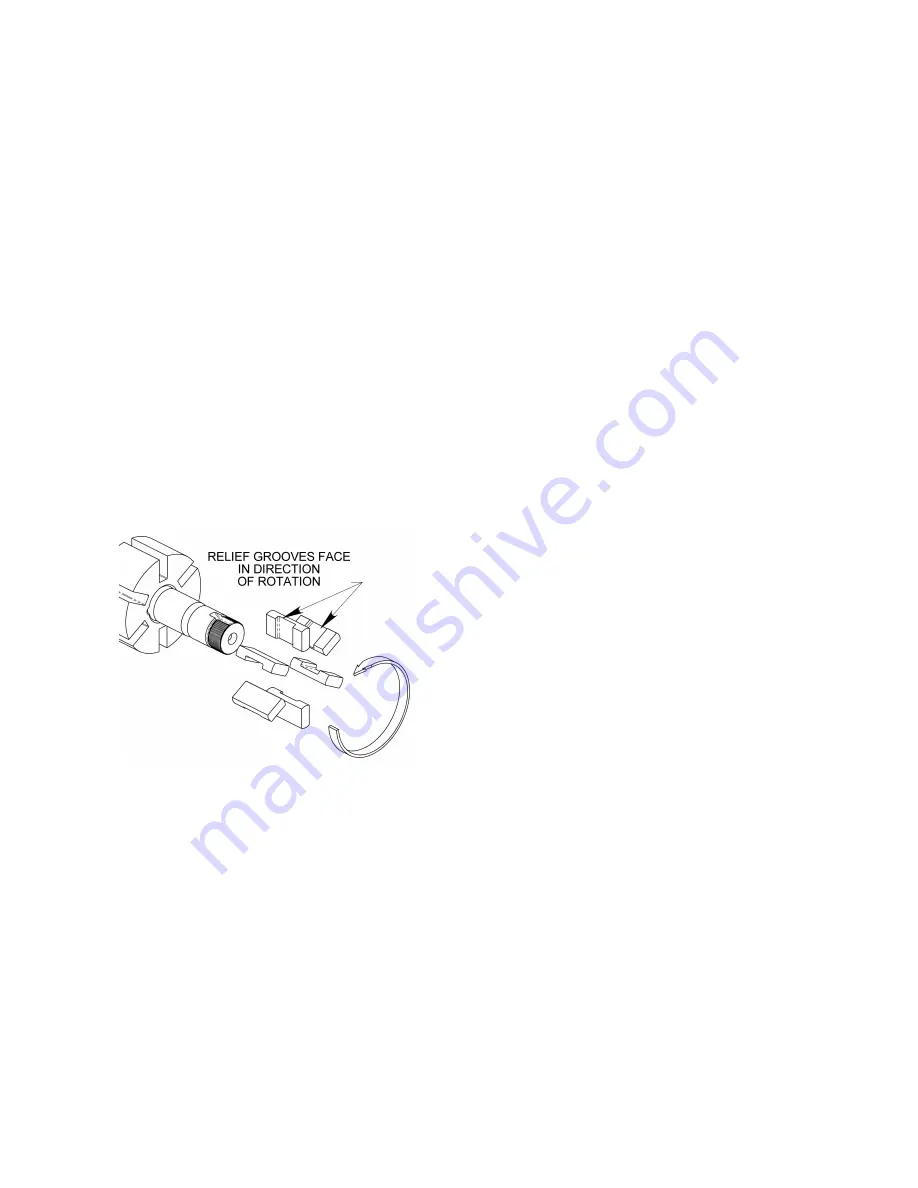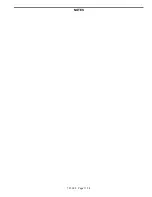
101-A00 Page 7/12
MAINTENANCE
VANE REPLACEMENT
NOTICE:
Maintenance shall be performed by qualified technicians
only. Following the appropriate procedures and
warnings as presented in manual.
NOTE:
The numbers in parentheses following individual
parts indicate reference numbers on the Pump Parts List.
1. Drain and relieve pressure from the pump and system as
required.
2. If the pump shaft is protruding through the cylinder (12),
remove the head assembly from the pump according to
steps 4 - 8 in the "Pump Disassembly" section of this
manual. If the pump shaft is protruding through the head
(20), remove the entire pump from the mounting bracket
(108 or 108B) (See Step 3 in "Pump Disassembly") then
remove the head assembly from the pump according to
steps 5 - 8 in the "Pump Disassembly" section of this
manual.
3. Turn the shaft by hand until a vane (14) comes to the top
(12 o'clock) position of the rotor. Remove the vane.
4. Install a new vane (14), ensuring that the relief groove is
facing toward the direction of rotation. See Figure 6.
5. Repeat steps 3 and 4 until all vanes have been replaced.
6. Reassemble the pump according to the "Pump
Assembly." section of this manual.
Figure 6 – Vane Replacement
PUMP DISASSEMBLY
NOTICE:
Follow all hazard warnings and instructions provided in
the “maintenance” section of this manual.
NOTE:
The numbers in parentheses following individual
parts indicate reference numbers on the Pump Parts List.
1. Drain and relieve pressure from the pump and system as
required.
2. Loosen the coupling (34) and remove the shaft key (35).
3. Remove the four mounting screws (28A) and remove the
entire pump assembly from the bracket mount (108 or
108B).
4. Remove the bearing cover capscrews (28), the bearing
cover (27) and gasket (26) Discard the bearing cover
gasket.
5. Remove the locknut (24A) and lockwasher (24B) from
the shaft end protruding through the head (20):
a. Bend up the engaged lockwasher tang and rotate
the locknut counterclockwise to remove it from the
shaft.
b. Slide the lockwasher off the shaft. Inspect the
lockwasher for damage and replace as required.
6. Clean the shaft portion protruding through the head
thoroughly, making sure the shaft is free of nicks and
burrs. This will prevent damage to the mechanical seal
when the head assembly is removed.
7. Remove the head capscrews (21) and carefully pry the
head (20) away from the cylinder.
8. Slide the head off the shaft. The head O-ring (72),
bearing (24), and mechanical seal (153) will come off
with the head assembly. Remove and discard the head
O-ring.
9. Pull the bearing (24) from the housing in the head.
10. Place a cloth under the seal to prevent damage. Using a
blunt instrument, gently push the stationary seat (153B)
to remove it from the head. Be careful not to contact the
seal faces during removal.
11. Remove and discard the mechanical seal O-rings (153D
and 153G).
12. Remove the locknut (24A) and lockwasher (24B) from
the shaft end protruding through the cylinder (12):
a. Bend up the engaged lockwasher tang and rotate
the locknut counterclockwise to remove it from the
shaft.
b. Slide the lockwasher off the shaft. Inspect the
lockwasher for damage and replace as required.
13. Clean the shaft protruding through the cylinder
thoroughly, making sure the shaft is free of nicks and
burrs.
14. Gently pull the rotor and shaft (13) from the cylinder.
While one hand is pulling the shaft, the other hand
should be cupped underneath the rotor to prevent the
vanes (14) from falling out. Carefully set the rotor and
shaft aside.
15. Remove vanes (14) from rotor and shaft (13).
16. Pull the bearing (24) from the cylinder.
17. Place a cloth under the seal to prevent damage. Using a
blunt instrument, gently push the stationary seat (153B)
to remove it from the head. Be careful not to contact the
seal faces during removal.
18. Remove and discard the mechanical seal O-rings (153D
and 153G).
PARTS REPLACEMENT
1. If any of the O-rings have been removed or disturbed
during disassembly, they must be replaced with new O-
rings.
2. Excessive or continuous leakage from the telltale hole in
the bearing cover may be an indication of a damaged
mechanical seal. If a mechanical seal has been leaking, it
is recommended the entire seal be replaced. Refer to
"General Pump Troubleshooting" for possible causes of
seal leakage.
Summary of Contents for XB1A
Page 11: ...101 A00 Page 11 12 NOTES...






























